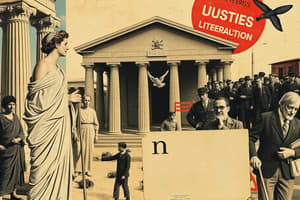Podcast
Questions and Answers
What is the purpose of the introduction (exordium)?
What is the purpose of the introduction (exordium)?
- To provide factual information about the subject
- To introduce the reader to the subject under discussion (correct)
- To include development or proof needed for the text
- To address counterarguments
What does the term 'narration' (narratio) provide?
What does the term 'narration' (narratio) provide?
Factual information and background material on the subject
What does confirmation (confirmatio) usually include?
What does confirmation (confirmatio) usually include?
- Development or proof needed to make the writer's case (correct)
- Bringing the essay to a close
- Addressing counterarguments
- Introducing the subject
What does the refutation (refutatio) typically address?
What does the refutation (refutatio) typically address?
What is the main goal of the conclusion (peroratio)?
What is the main goal of the conclusion (peroratio)?
Flashcards are hidden until you start studying
Study Notes
Introduction (Exordium)
- Introduces the topic and engages the reader's interest.
- Originates from Latin term meaning "beginning a web."
- Establishes writer's credibility (ethos).
- Can vary in length from one paragraph to several.
Narration (Narratio)
- Provides essential background information and context.
- Begins the developmental paragraphs of the essay.
- Justifies why the subject is significant or problematic.
- Appeals primarily to logos but often evokes emotional responses (pathos) from the audience.
Confirmation (Confirmatio)
- Considered the main content of the essay.
- Contains detailed evidence and arguments supporting the writer's case.
- Focuses on providing concrete specifics to strengthen the argument.
- Primarily appeals to logos (logical reasoning).
Refutation (Refutatio)
- Addresses opposing arguments, serving as a transition between proof and conclusion.
- Typically placed towards the end of the text but can vary based on audience familiarity with counterarguments.
- Engages with opposing views to strengthen the primary argument.
- Appeals to logos, reinforcing logical reasoning and countering objections.
Conclusion (Peroratio)
- Summarizes the essay and provides a compelling closure.
- Appeals to pathos, reinforcing emotional engagement with the audience.
- Reminds readers of the writer's established credibility (ethos).
- Integrates ideas and answers the overarching question, "so what?"
- Last statements are crucial for audience retention and impact.
Studying That Suits You
Use AI to generate personalized quizzes and flashcards to suit your learning preferences.





